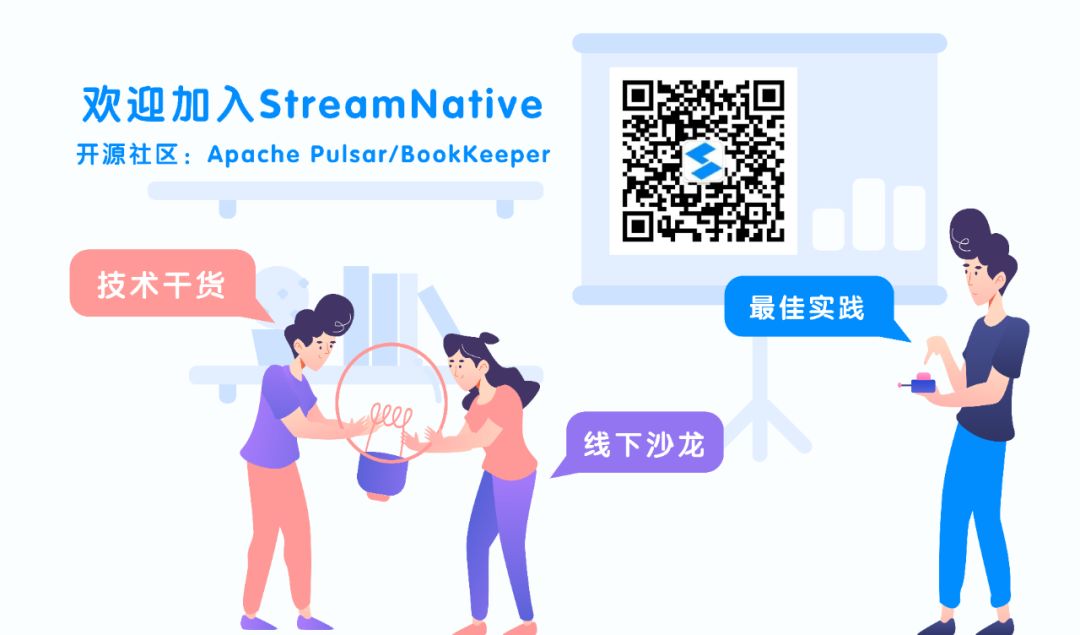
🎙️阅读本文需要 5 分钟
⌨️ 引入依赖
<dependency><groupId>org.apache.pulsar</groupId><artifactId>pulsar-client-kafka</artifactId><version>{project.version}</version></dependency>
⌨️ 使用 Kafka Schema
>>> 添加生产者代码
String topic = "persistent://public/default/test";Properties props = new Properties();props.put("bootstrap.servers", "pulsar://localhost:6650");props.put("key.serializer", IntegerSerializer.class.getName());props.put("value.serializer", StringSerializer.class.getName());Producer<Integer, String> producer = new KafkaProducer<>(props);for (int i = 0; i < 10; i++) {producer.send(new ProducerRecord<Integer, String>(topic, i, Integer.toString(i)));}producer.close();
>>> 添加消费者代码
String topic = "persistent://public/default/test";Properties props = new Properties();props.put("bootstrap.servers", "pulsar://localhost:6650");props.put("group.id", "my-subscription-name");props.put("enable.auto.commit", "false");props.put("key.deserializer", IntegerDeserializer.class.getName());props.put("value.deserializer", StringDeserializer.class.getName());("resource")Consumer<Integer, String> consumer = new KafkaConsumer<>(props);consumer.subscribe(Arrays.asList(topic));while (true) {ConsumerRecords<Integer, String> records = consumer.poll(100);records.forEach(record -> {log.info("Received record: {}", record);});// Commit last offsetconsumer.commitSync();}
⌨️ 使用 Pulsar Schema
@Data@ToString@EqualsAndHashCodepublic class Foo {private String field1;private String field2;private int field3;}@Data@ToString@EqualsAndHashCodepublic class Bar {private boolean field1;}
>>> 生产者端代码
String topic = "persistent://public/default/test-avro";Properties props = new Properties();props.put("bootstrap.servers", "pulsar://localhost:6650");props.put("key.serializer", IntegerSerializer.class.getName());props.put("value.serializer", StringSerializer.class.getName());AvroSchema<Bar> barSchema = AvroSchema.of(SchemaDefinition.<Bar>builder().withPojo(Bar.class).build());AvroSchema<Foo> fooSchema = AvroSchema.of(SchemaDefinition.<Foo>builder().withPojo(Foo.class).build());Bar bar = new Bar();bar.setField1(true);Foo foo = new Foo();foo.setField1("field1");foo.setField2("field2");foo.setField3(3);Producer<Foo, Bar> producer = new KafkaProducer<>(props, fooSchema, barSchema);for (int i = 0; i < 10; i++) {producer.send(new ProducerRecord<Foo, Bar>(topic, i, foo, bar));log.info("Message {} sent successfully", i);}producer.close();
>>> 消费者端代码
String topic = "persistent://public/default/test-avro";Properties props = new Properties();props.put("bootstrap.servers", "pulsar://localhost:6650");props.put("group.id", "my-subscription-name");props.put("enable.auto.commit", "false");props.put("key.deserializer", IntegerDeserializer.class.getName());props.put("value.deserializer", StringDeserializer.class.getName());AvroSchema<Bar> barSchema = AvroSchema.of(SchemaDefinition.<Bar>builder().withPojo(Bar.class).build());AvroSchema<Foo> fooSchema = AvroSchema.of(SchemaDefinition.<Foo>builder().withPojo(Foo.class).build());Bar bar = new Bar();bar.setField1(true);Foo foo = new Foo();foo.setField1("field1");foo.setField2("field2");foo.setField3(3);("resource")Consumer<Foo, Bar> consumer = new PulsarKafkaConsumer<>(props, fooSchema, barSchema);consumer.subscribe(Arrays.asList(topic));while (true) {ConsumerRecords<Foo, Bar> records = consumer.poll(100);records.forEach(record -> {log.info("Received record: {}", record);});// Commit last offsetconsumer.commitSync();}
更多关于 Kafka Client 中支持的配置,可以参考 Pulsar 官网。

本文分享自微信公众号 - StreamNative(StreamNative)。
如有侵权,请联系 support@oschina.cn 删除。
本文参与“OSC源创计划”,欢迎正在阅读的你也加入,一起分享。
来源:oschina
链接:https://my.oschina.net/u/3742918/blog/4466692